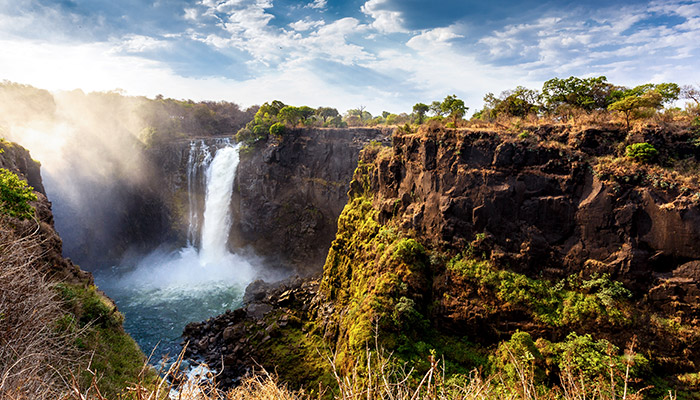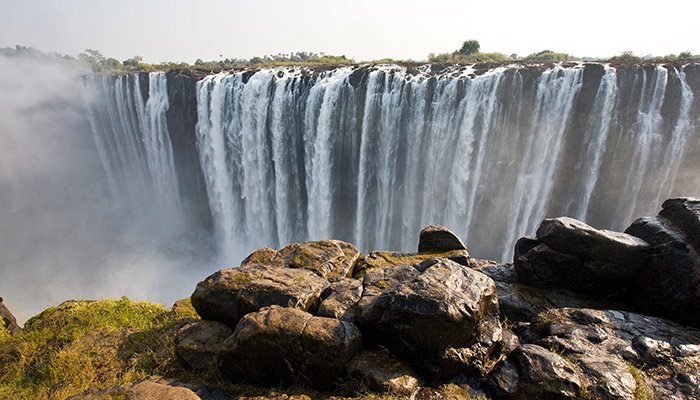As I took my first step off the plane in Livingstone, the cooling air con of the cabin was decimated by a wave of immense heat that baked the tarmac of the diminutive landing strip and rippled the horizon. An appropriate welcome to the hottest continent on the planet. Bleary eyed from a nap made restless by my immeasurable excitement during the flight, I passed through customs, gathered my luggage and headed for the tiny airport’s exit. As soon as I passed the threshold, I was met with the inevitable barrage of local taxi drivers trying to sell their services. Each with their own sales pitch on the greatest attraction that the area has to offer – Victoria Falls.
The falls are what cemented this region of Africa’s place as a must visit stop on the tourism trail and as you approach the Zambian town from its airport, it shows. Hotels, shops and restaurants have all adopted Victoria Falls as their prime sales angle. Images of the falls are painted on walls, wedged into the names of establishments and you can be sure that your taxi driver will bring up the subject within the first three minutes of your journey. Unlike many tourist draws, Victoria Falls is not seen in a negative light by the local community. It brings income to hundreds, which in turn lowers homelessness and crime rates in the region – an issue that is rife elsewhere in the country. The inhabitants of Livingstone are thankful for the numbers that the falls attracts, rather than lamenting them.
Opting against heading straight to the region’s iconic landmark, I asked instead to be dropped at my accommodation (one of the better decisions that I made during my trip). Wandering through the hotel’s courtyard surrounded by sporadic groups of travellers enjoying some shaded downtime, I dropped off my bag and sparked up a conversation with a group who I later discovered were part of my tour group. They had visited the Zambezi River’s most famous landmark that morning and told individual stories of the awe-inspiring, colossal might of the falls. But with each excited story came the same warning – you will get wet!
Heeding the warnings but unable to contain my excitement any longer, I threw on my waterproof coat, ordered a taxi and set off for one of Southern Africa’s greatest natural phenomena.

Arriving at the gate, I felt like my adventure in Africa had truly begun. The journey to the site itself was fraught with an excitable anticipation that was bolstered by the road’s route through the elephant corridor of Mosi-oa-Tunya National Park. The concept of spotting a wild elephant during a simple drive from A to B was almost beyond my comprehension. Whilst no elephants were spotted on this occasion, the simple suggestion that this was a common occurrence opened my eyes to the poetic manner in which local life in Africa entwines with the animals that call the continent home.
As the faint rumble of cascading water hummed in the background I entered the ticket office only to be met by the stare of a wild baboon, sat upright and munching on a banana salvaged from the bin. If the elephant corridor hadn’t been evidence enough of Africa’s endearingly wild heart then this surely was. Attempting to ignore the casual ape in the corner with the same casual air as the office’s officials, I purchased my ticket and slipped out so as to avoid another intimidating gaze from the corner’s feral occupant.
This is where the true excitement began.
With each anticipation-fuelled step the hum of the tumbling river grew closer to a roar. The faint spray of the falls began to topple between the leaves of the tree-clad pathways. Visitors wandered by in the other direction, soaked to the skin with smiles of pure delight plastered across their faces. As I witnessed the great Zambezi River reduced to nothing but a fine mist that danced above the horizon, the true extent of Victoria Falls’ immense power started to dawn on me. Whilst I pondered this, the African canopy began to part like a dispersing crowd and revealed the incredible spectacle of one of the 7 Natural Wonders of the World.

The rushing waters of the Zambezi framed by the surrounding trees alone was a remarkable sight, but the dramatic plummet to the rocks below was unlike anything I had ever witnessed or heard in my life. The thunderous crash of the waterfall was so immeasurably mighty that the other end of the falls remained invisible behind a thick veil of erupting river, thrown up by the crashing impact with the rocks below.
The falls dramatically cascade opposite intimidatingly steep cliffs that present the perfect platform from which to witness this great feat of nature. However, said cliffs are only accessible via the aptly named ‘Knife Edge Bridge’ – a narrow, rickety walkway which is bombarded by a constant downpour that could match the drama of any storm during Asia’s monsoon season. As I ran across the bridge, despite the heroic efforts of my waterproof jacket, I was absolutely drenched.
Alone other than the natural drum of the falls, soaked from head to toe and baking in the African heat, I trudged through the clifftop tree line to its very edge. Stood gazing at the falls that spread beyond my sight on both sides, three perfectly formed concentric rainbows shimmering below and the river water showering over me like a natural baptism on the most dramatic scale, I had one thought in mind – what a perfect introduction to Africa.

